

Compact Muon Solenoid
LHC, CERN
| CMS-PAS-B2G-16-007 | ||
| Combination of searches for WW, WZ, ZZ, WH, and ZH resonances at $\sqrt{s} = $ 8 and 13 TeV | ||
| CMS Collaboration | ||
| May 2016 | ||
| Abstract: The statistical combination of searches for massive resonances decaying to pairs of W, Z, and Higgs bosons based on pp collision data collected by the CMS experiment at the CERN LHC is presented. The data are taken at a centre-of-mass energy of 8 and 13 TeV and correspond to an integrated luminosity of 19.7 fb$^{-1}$ and 2.6 fb$^{-1}$ respectively. The results are interpreted in the context of a heavy vector triplet model that mimics the properties of composite Higgs models predicting a W' and a Z' decaying to WZ, WH, WW, and ZH and a model with a "bulk" graviton that decays into WW and ZZ. Combined cross section limits as a function of resonance mass are obtained. The combined significance of potential resonances of 1.8-2 TeV are evaluated in each signal hypothesis. | ||
|
Links:
CDS record (PDF) ;
inSPIRE record ;
CADI line (restricted) ;
These preliminary results are superseded in this paper, PLB 774 (2017) 533. The superseded preliminary plots can be found here. |
||
| Figures | |
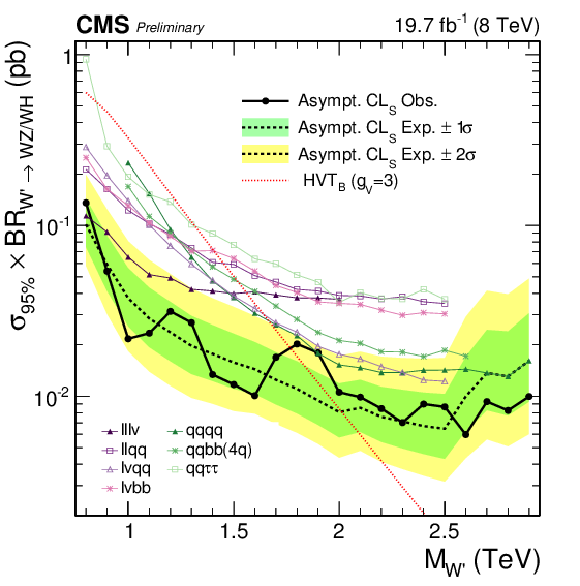
png pdf |
Figure 1-a:
(top left) Observed (black solid) and expected (black dashed) exclusion limits at 95% CL on $\sigma ( \rm pp \to {\rm W^\prime } \to \mathrm{WZ/WH})$ as a function of the resonance mass obtained by combining the 8 TeV diboson searches. The curve corresponding to the cross sections predicted by the HVT model B is overlaid. (top right) Observed (black solid) and expected (black dashed) exclusion limits at 95% CL on $\sigma ( \rm pp \to {\rm W^\prime } \to \mathrm{ WZ/WH })$ as a function of the resonance mass obtained by combining the 13 TeV diboson searches. The curve corresponding to the cross sections predicted by the HVT model B is overlaid. (bottom) Exclusion limits at 95% CL on the signal strength as a function of the resonance mass obtained by combining the 8 and 13 TeV diboson searches. In each of the three plots the different colored lines correspond to the searches entering the combination. |
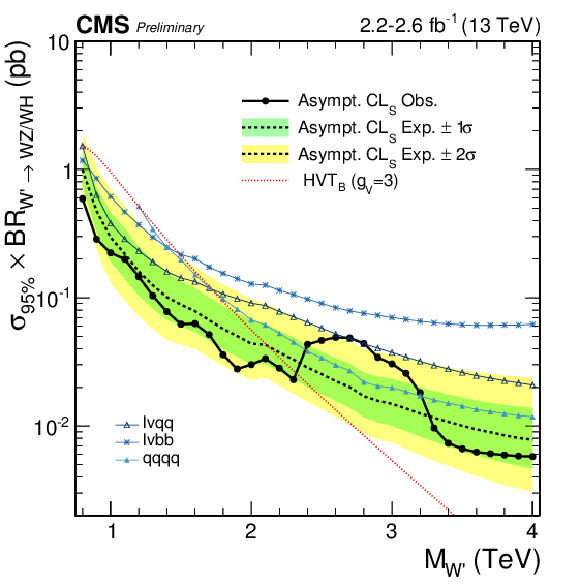
png pdf |
Figure 1-b:
(top left) Observed (black solid) and expected (black dashed) exclusion limits at 95% CL on $\sigma ( \rm pp \to {\rm W^\prime } \to \mathrm{WZ/WH})$ as a function of the resonance mass obtained by combining the 8 TeV diboson searches. The curve corresponding to the cross sections predicted by the HVT model B is overlaid. (top right) Observed (black solid) and expected (black dashed) exclusion limits at 95% CL on $\sigma ( \rm pp \to {\rm W^\prime } \to \mathrm{ WZ/WH })$ as a function of the resonance mass obtained by combining the 13 TeV diboson searches. The curve corresponding to the cross sections predicted by the HVT model B is overlaid. (bottom) Exclusion limits at 95% CL on the signal strength as a function of the resonance mass obtained by combining the 8 and 13 TeV diboson searches. In each of the three plots the different colored lines correspond to the searches entering the combination. |

png pdf |
Figure 1-c:
(top left) Observed (black solid) and expected (black dashed) exclusion limits at 95% CL on $\sigma ( \rm pp \to {\rm W^\prime } \to \mathrm{WZ/WH})$ as a function of the resonance mass obtained by combining the 8 TeV diboson searches. The curve corresponding to the cross sections predicted by the HVT model B is overlaid. (top right) Observed (black solid) and expected (black dashed) exclusion limits at 95% CL on $\sigma ( \rm pp \to {\rm W^\prime } \to \mathrm{ WZ/WH })$ as a function of the resonance mass obtained by combining the 13 TeV diboson searches. The curve corresponding to the cross sections predicted by the HVT model B is overlaid. (bottom) Exclusion limits at 95% CL on the signal strength as a function of the resonance mass obtained by combining the 8 and 13 TeV diboson searches. In each of the three plots the different colored lines correspond to the searches entering the combination. |
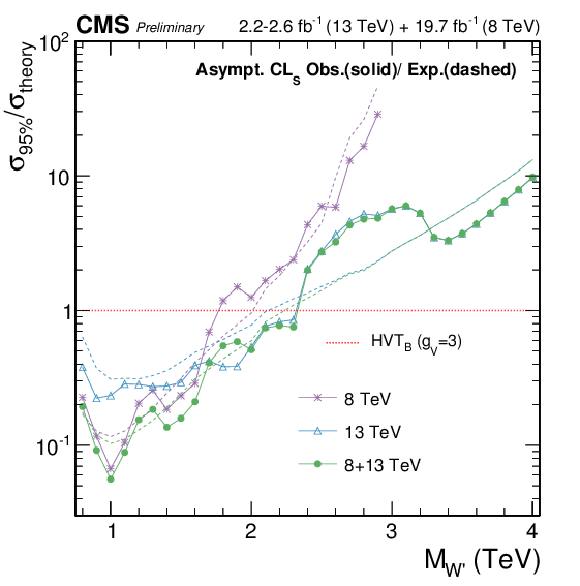
png pdf |
Figure 2:
Comparison of the observed (solid) and expected (dashed) exclusion limits at 95% CL obtained by combining only 8 TeV or only 13 TeV searches to the results from the combination of all the 8 and 13 TeV results. |
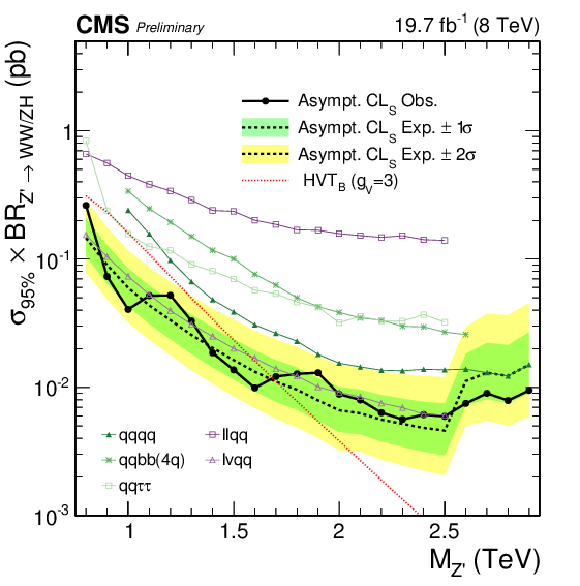
png pdf |
Figure 3-a:
(top left) Observed (black solid) and expected (black dashed) exclusion limits at 95% CL on $\sigma ( \rm pp \to {\rm Z^\prime } \to \mathrm{ WW/ZH })$ as a function of the resonance mass obtained by combining the 8 TeV diboson searches. The curve corresponding to the cross sections predicted by the HVT model B is overlaid. (top right) Observed (black solid) and expected (black dashed) exclusion limits at 95% CL on $\sigma ( \rm pp \to {\rm Z^\prime } \to \mathrm{ WW/ZH })$ as a function of the resonance mass obtained by combining the 13 TeV diboson searches. The curve corresponding to the cross sections predicted by the HVT model B is overlaid. (bottom) Exclusion limits at 95% CL on the signal strength as a function of the resonance mass obtained by combining the 8 and 13 TeV diboson searches. In each of the three plots the different colored lines correspond to the searches entering the combination. |
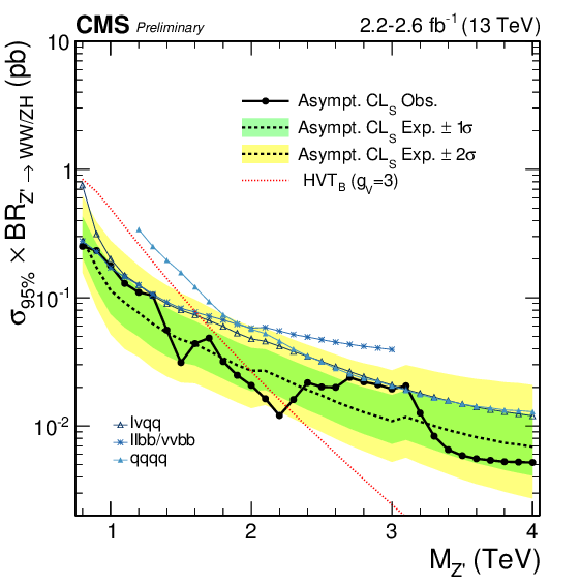
png pdf |
Figure 3-b:
(top left) Observed (black solid) and expected (black dashed) exclusion limits at 95% CL on $\sigma ( \rm pp \to {\rm Z^\prime } \to \mathrm{ WW/ZH })$ as a function of the resonance mass obtained by combining the 8 TeV diboson searches. The curve corresponding to the cross sections predicted by the HVT model B is overlaid. (top right) Observed (black solid) and expected (black dashed) exclusion limits at 95% CL on $\sigma ( \rm pp \to {\rm Z^\prime } \to \mathrm{ WW/ZH })$ as a function of the resonance mass obtained by combining the 13 TeV diboson searches. The curve corresponding to the cross sections predicted by the HVT model B is overlaid. (bottom) Exclusion limits at 95% CL on the signal strength as a function of the resonance mass obtained by combining the 8 and 13 TeV diboson searches. In each of the three plots the different colored lines correspond to the searches entering the combination. |
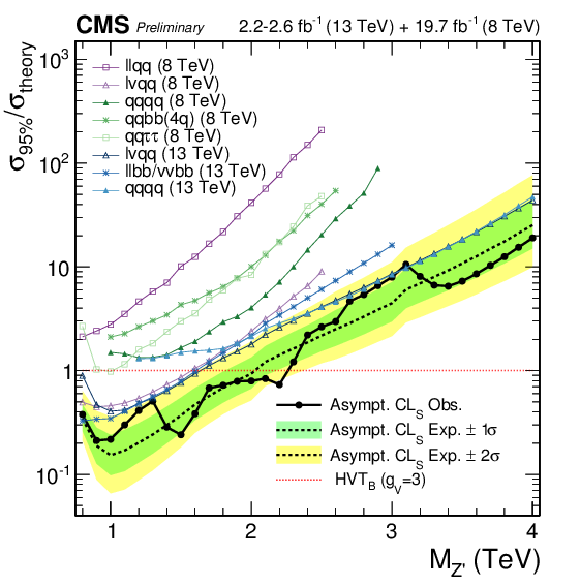
png pdf |
Figure 3-c:
(top left) Observed (black solid) and expected (black dashed) exclusion limits at 95% CL on $\sigma ( \rm pp \to {\rm Z^\prime } \to \mathrm{ WW/ZH })$ as a function of the resonance mass obtained by combining the 8 TeV diboson searches. The curve corresponding to the cross sections predicted by the HVT model B is overlaid. (top right) Observed (black solid) and expected (black dashed) exclusion limits at 95% CL on $\sigma ( \rm pp \to {\rm Z^\prime } \to \mathrm{ WW/ZH })$ as a function of the resonance mass obtained by combining the 13 TeV diboson searches. The curve corresponding to the cross sections predicted by the HVT model B is overlaid. (bottom) Exclusion limits at 95% CL on the signal strength as a function of the resonance mass obtained by combining the 8 and 13 TeV diboson searches. In each of the three plots the different colored lines correspond to the searches entering the combination. |
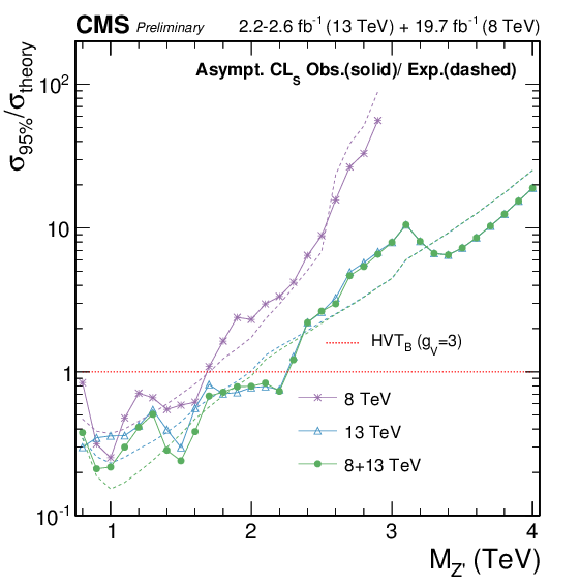
png pdf |
Figure 4:
Comparison of the observed (solid) and expected (dashed) exclusion limits at 95% CL obtained by combining only 8 TeV or only 13 TeV searches to the results from the combination of all the 8 and 13 TeV results. |
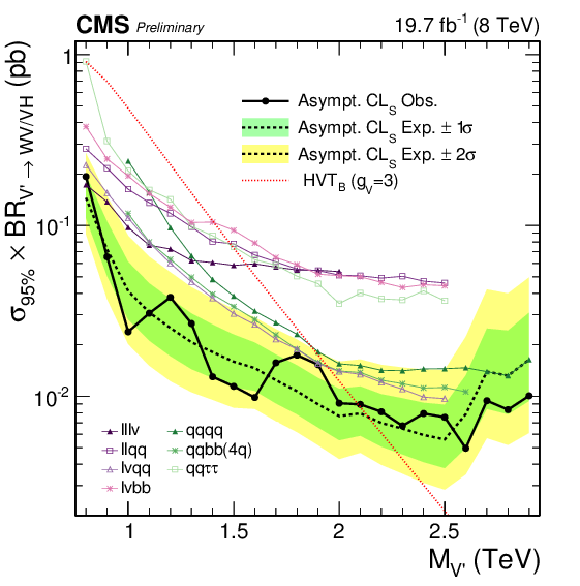
png pdf |
Figure 5-a:
Observed (black solid) and expected (black dashed) exclusion limits at 95% CL on $\sigma ( \rm pp \to {\rm V^\prime } \to \mathrm{ WV/VH }$ ($ {\rm V^\prime } = {\rm W^\prime } $, ${\rm Z^\prime }$ and $\mathrm{ V=W,Z }$) as a function of the resonance mass obtained by combining the 8 TeV diboson searches. The curve corresponding to the cross sections predicted by the HVT model B is overlaid. |

png pdf |
Figure 5-b:
Observed (black solid) and expected (black dashed) exclusion limits at 95% CL on $\sigma ( \rm pp \to {\rm V^\prime } \to \mathrm{ WV/VH })$ as a function of the resonance mass obtained by combining the 13 TeV diboson searches. The curve corresponding to the cross sections predicted by the HVT model B is overlaid. |
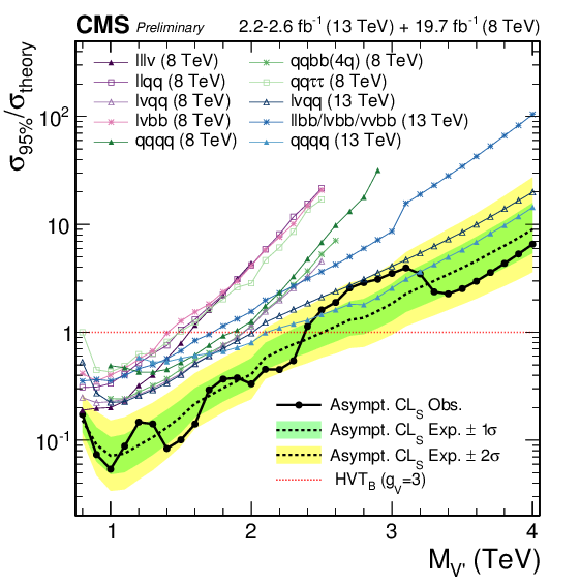
png pdf |
Figure 5-c:
Exclusion limits at 95% CL on the signal strength as a function of the resonance mass obtained by combining the 8 and 13 TeV diboson searches. In all the three plots the different colored lines correspond to the searches entering the combination. |
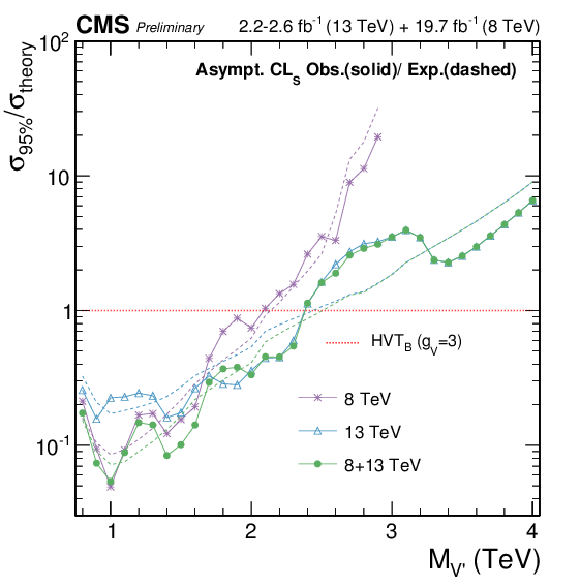
png pdf |
Figure 6:
Comparison of the observed (solid) and expected (dashed) exclusion limits at 95% CL obtained by combining only 8 TeV or only 13 TeV searches to the results from the combination of all the 8 and 13 TeV results. |

png pdf |
Figure 7:
Exclusion regions in the plane of the HVT-model couplings ($g_{\rm V}c_{\rm H}$, $g^2c_{\rm F}/g_{\rm V}$ ) for three resonance masses, 1.5, 2, and 3 TeV, where $g$ denotes the weak gauge coupling. The point B of the benchmark model used in the analysis is also shown. The boundaries of the regions outside these lines are excluded by this search are indicated by the solid and dashed lines. The areas indicated by the solid shading correspond to regions where the resonance width is predicted to be more than 7% of the resonance mass and the narrow-resonance assumption is not satisfied. |
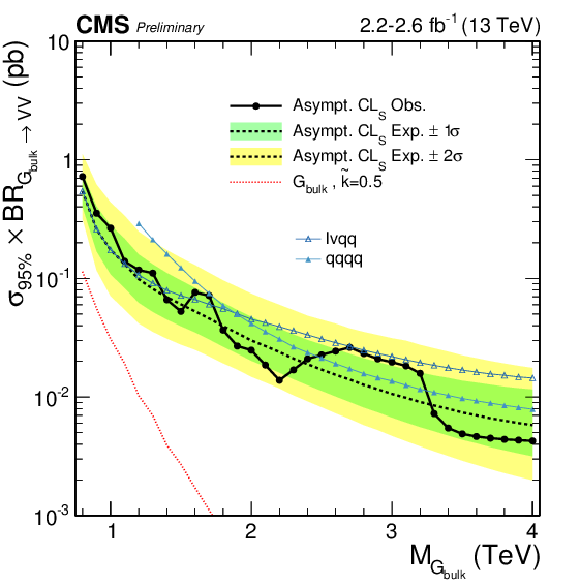
png pdf |
Figure 8-a:
Observed (black solid) and expected (black dashed) exclusion limits at 95% CL on $\sigma ( \rm pp \to G_{bulk} \to \mathrm{ VV })$ ($\mathrm{ V=W,Z}$) as a function of the resonance mass obtained by combining the 13 TeV diboson searches. The curve corresponding to the cross sections predicted by bulk graviton model is overlaid. |
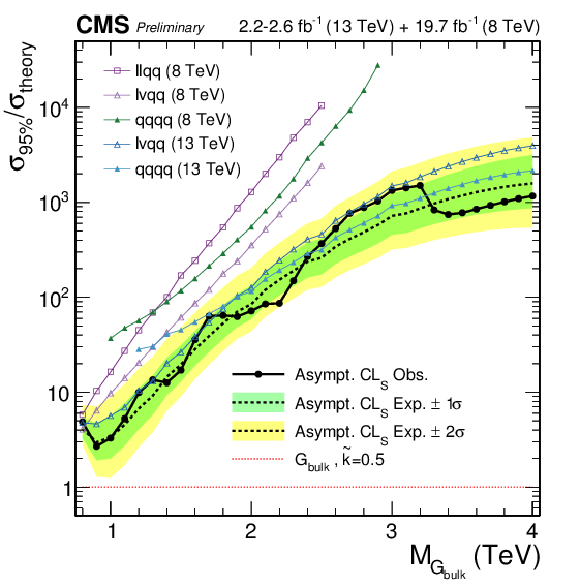
png pdf |
Figure 8-b:
Exclusion limits at 95% CL on the signal strength as a function of the resonance mass obtained by combining the 8 and 13 TeV diboson searches. In all the three plots the different colored lines correspond to the searches entering the combination. |

png pdf |
Figure 9:
Comparison of the observed (solid) and expected (dashed) exclusion limits at 95% CL obtained by combining only 8 TeV or only 13 TeV searches to the results from the combination of all the 8 and 13 TeV results. |
| Tables | |

png pdf |
Table 1:
Summary of the properties of heavy resonances considered in the combination. |
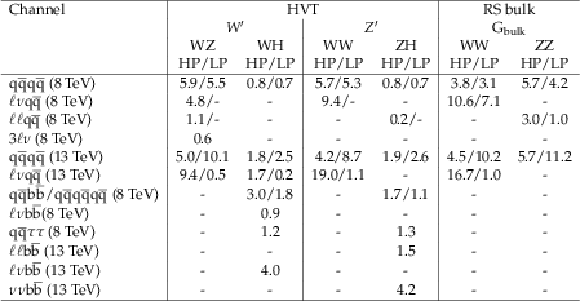
png pdf |
Table 2:
Summary of the signal efficiencies of all analysis channels for all signal models for a 2 TeV resonance in both high-purity (HP) and low-purity (LP) categories. The signal efficiencies are in percent and include the branching ratios of the two vector bosons to the final state of the analysis channel, effects from detector acceptance, as well as reconstruction and selection efficiencies. |

png pdf |
Table 3:
Summary of the dominant backgrounds and their estimation methods in each analysis channel. |
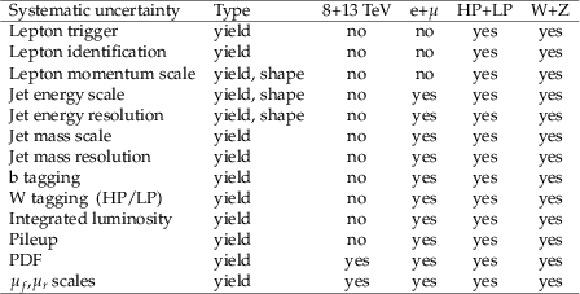
png pdf |
Table 4:
Correlation of systematic uncertainties. |
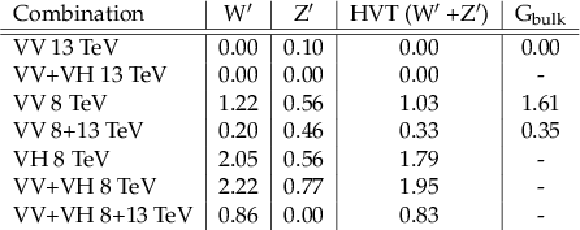
png pdf |
Table 5:
Statistical significance of excesses observed at 1.8 TeV in the various searches, expressed in standard deviations. |
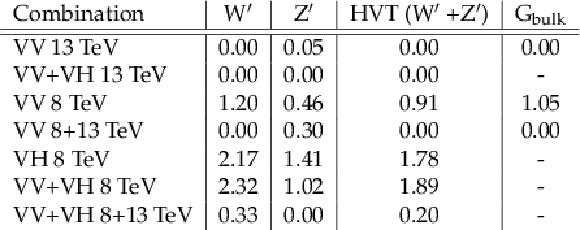
png pdf |
Table 6:
Statistical significance of excesses observed at 1.9 TeV in the various searches, expressed in standard deviations. |
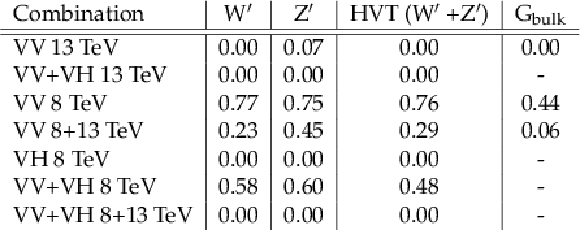
png pdf |
Table 7:
Statistical significance of excesses observed at 2 TeV in the various searches, expressed in standard deviations. |
| Summary |
| The statistical combination of searches for massive resonances decaying to WW, ZZ, WZ, WH, and ZH boson pairs has been presented. The considered searches are based on pp collision data collected by the CMS experiment at a centre-of-mass energy of 8 and 13 TeV, corresponding to an integrated luminosity of 19.7 fb$^{-1}$ and 2.2-2.6 fb$^{-1}$, respectively. The results are interpreted in the context of heavy vector singlet and triplet models predicting a W' and a Z' decaying to WZ, WH, WW, and ZH and a model with a "bulk" graviton that decays into WW and ZZ. The combination yields the most stringent resonance mass limits to date on W' and Z' singlets at 2.3 TeV and 1.8 TeV, respectively, and on a heavy vector triplet at 2.4 TeV. The combination also yields the most stringent cross section limits on a narrow bulk graviton resonance to date in the mass range from 0.8 to 4 TeV. Finally, the combined significance of a potential resonances at 1.8-2.0 TeV is evaluated and found to be 0.9$\sigma$ for the hypothesis of a W' that yields the highest significance among all considered signal hypotheses. |
| References | ||||
| 1 | L. Randall and R. Sundrum | A Large mass hierarchy from a small extra dimension | PRL 83 (1999) 3370 | hep-ph/9905221 |
| 2 | L. Randall and R. Sundrum | An Alternative to compactification | PRL 83 (1999) 4690 | hep-th/9906064 |
| 3 | B. Bellazzini, C. Cs\'aki, and J. Serra | Composite Higgses | EPJC 74 (2014) 2766 | 1401.2457 |
| 4 | R. Contino, D. Marzocca, D. Pappadopulo, and R. Rattazzi | On the effect of resonances in composite Higgs phenomenology | JHEP 10 (2011) 081 | 1109.1570 |
| 5 | D. Marzocca, M. Serone, and J. Shu | General composite Higgs models | JHEP 08 (2012) 013 | 1205.0770 |
| 6 | D. Greco and D. Liu | Hunting composite vector resonances at the LHC: naturalness facing data | JHEP 12 (2014) 126 | 1410.2883 |
| 7 | CMS Collaboration | Search for massive resonances decaying into pairs of boosted W and Z bosons at $ \sqrt{s} $=13 TeV | CMS-PAS-EXO-15-002 | CMS-PAS-EXO-15-002 |
| 8 | CMS Collaboration | Search for heavy resonances decaying into a vector boson and a Higgs boson in the ($ \ell\ell $, $ \ell\Pgn $, $ \Pgn\Pgn $) $ \mathrm{ b \bar{b} } $ final state | CMS-PAS-B2G-16-003 | CMS-PAS-B2G-16-003 |
| 9 | CMS Collaboration | Search for massive resonances decaying into pairs of boosted bosons in semi-leptonic final states at $ \sqrt{s}= $ 8 TeV | JHEP 08 (2014) 174 | CMS-EXO-13-009 1405.3447 |
| 10 | CMS Collaboration | Search for massive resonances in dijet systems containing jets tagged as W or Z boson decays in pp collisions at $ \sqrt{s} $ = 8 TeV | JHEP 08 (2014) 173 | CMS-EXO-12-024 1405.1994 |
| 11 | CMS Collaboration | Search for a massive resonance decaying into a Higgs boson and a W or Z boson in hadronic final states in proton-proton collisions at $ \sqrt{s}=8 $ TeV | JHEP 02 (2016) 145 | CMS-EXO-14-009 1506.01443 |
| 12 | CMS Collaboration | Search for new resonances decaying via WZ to leptons in proton-proton collisions at $ \sqrt s = $ 8 TeV | PLB 740 (2015) 83 | CMS-EXO-12-025 1407.3476 |
| 13 | CMS Collaboration | Search for massive WH resonances decaying into the $ \ell \nu \mathrm{b} \overline{\mathrm{b}} $ final state at $ \sqrt{s}=8 $ $ ~\text {TeV} $ | EPJC 76 (2016) 237 | CMS-EXO-14-010 1601.06431 |
| 14 | CMS Collaboration | Search for Narrow High-Mass Resonances in Proton-Proton Collisions at $ \sqrt{s} $ = 8 TeV Decaying to a Z and a Higgs Boson | PLB 748 (2015) 255 | CMS-EXO-13-007 1502.04994 |
| 15 | ATLAS Collaboration | Search for high-mass diboson resonances with boson-tagged jets in proton-proton collisions at $ \sqrt{s}=8 $ TeV with the ATLAS detector | JHEP 12 (2015) 055 | 1506.00962 |
| 16 | K. Agashe, H. Davoudiasl, G. Perez, and A. Soni | Warped Gravitons at the LHC and Beyond | PRD 76 (2007) 036006 | hep-ph/0701186 |
| 17 | A. L. Fitzpatrick, J. Kaplan, L. Randall, and L.-T. Wang | Searching for the Kaluza-Klein Graviton in Bulk RS Models | JHEP 09 (2007) 013 | hep-ph/0701150 |
| 18 | O. Antipin, D. Atwood, and A. Soni | Search for RS gravitons via $ W_LW_L $ decays | PLB 666 (2008) 155 | 0711.3175 |
| 19 | D. Pappadopulo, A. Thamm, R. Torre, and A. Wulzer | Heavy Vector Triplets: Bridging Theory and Data | JHEP 09 (2014) 060 | 1402.4431 |
| 20 | M. Schmaltz and D. Tucker-Smith | Little Higgs review | Ann. Rev. Nucl. Part. Sci. 55 (2005) 229 | hep-ph/0502182 |
| 21 | N. Arkani-Hamed, A. Cohen, E. Katz, and A. Nelson | The Littlest Higgs | JHEP 07 (2002) 034 | hep-ph/0206021 |
| 22 | G. Altarelli, B. Mele, and M. Ruiz-Altaba | Searching for new heavy vector bosons in $ p\bar{p} $ colliders | Zeitschrift f\"ur Physik C Particles and Fields 45 (1989) 109 | |
| 23 | CMS Collaboration | Search for physics beyond the standard model in final states with a lepton and missing transverse energy in proton-proton collisions at $ \sqrt{s}=8 $ TeV | PRD 91 (2015) 092005 | CMS-EXO-12-060 1408.2745 |
| 24 | ATLAS Collaboration | Search for new particles in events with one lepton and missing transverse momentum in pp collisions at $ \sqrt{s}=8 $ TeV with the ATLAS detector | JHEP 09 (2014) 037 | 1407.7494 |
| 25 | CMS Collaboration | Search for SSM W' production, in the lepton+MET final state at a center-of-mass energy of 13 TeV | CMS-PAS-EXO-15-006 | CMS-PAS-EXO-15-006 |
| 26 | ATLAS Collaboration | Combination of searches for $ WW $, $ WZ $, and $ ZZ $ resonances in $ pp $ collisions at $ \sqrt{s} = 8 $ TeV with the ATLAS detector | PLB 755 (2016) 285 | 1512.05099 |
| 27 | ATLAS Collaboration | Search for production of $ WW/WZ $ resonances decaying to a lepton, neutrino and jets in $ pp $ collisions at $ \sqrt{s}=8 $ TeV with the ATLAS detector | EPJC 75 (2015) 209, , [Erratum: $Eur. Phys. J. C 75$ (2015) 370] | 1503.04677 |
| 28 | ATLAS Collaboration | Search for WZ resonances in the fully leptonic channel using pp collisions at $ \sqrt{s} $ = 8 TeV with the ATLAS detector | PLB 737 (2014) 223 | 1406.4456 |
| 29 | CMS Collaboration | Search for physics beyond the standard model in dilepton mass spectra in proton-proton collisions at $ \sqrt{s}=8 $ TeV | JHEP 04 (2015) 025 | CMS-EXO-12-061 1412.6302 |
| 30 | ATLAS Collaboration | Search for high-mass dilepton resonances in pp collisions at $ \sqrt{s}=8 $ TeV with the ATLAS detector | PRD 90 (2014) 052005 | 1405.4123 |
| 31 | CMS Collaboration | Search for a Narrow Resonance Produced in 13 TeV pp Collisions Decaying to Electron Pair or Muon Pair Final States | CMS-PAS-EXO-15-005 | CMS-PAS-EXO-15-005 |
| 32 | ATLAS Collaboration | Search for a new resonance decaying to a W or Z boson and a Higgs boson in the $ \ell \ell / \ell \nu / \nu \nu + b \bar{b} $ final states with the ATLAS detector | EPJC 75 (2015) 263 | 1503.08089 |
| 33 | M. Wobisch and T. Wengler | Hadronization corrections to jet cross-sections in deep inelastic scattering | in Monte Carlo generators for HERA physics. Proceedings, Workshop, Hamburg, Germany, 1998-1999.\newblock 1998.\newblock\newblock | hep-ph/9907280 |
| 34 | M. Cacciari, G. P. Salam, and G. Soyez | The anti-$ k_t $ jet clustering algorithm | JHEP 04 (2008) 063 | 0802.1189 |
| 35 | S. D. Ellis, C. K. Vermilion, and J. R. Walsh | Techniques for improved heavy particle searches with jet substructure | PRD 80 (2009) 051501 | 0903.5081 |
| 36 | S. D. Ellis, C. K. Vermilion, and J. R. Walsh | Recombination Algorithms and Jet Substructure: Pruning as a Tool for Heavy Particle Searches | PRD 81 (2010) 094023 | 0912.0033 |
| 37 | J. Thaler and K. Van Tilburg | Identifying Boosted Objects with N-subjettiness | JHEP 03 (2011) 015 | 1011.2268 |
| 38 | R. D. Ball et al. | Impact of Heavy Quark Masses on Parton Distributions and LHC Phenomenology | Nucl. Phys. B 849 (2011) 296 | 1101.1300 |
| 39 | M. Cacciari et al. | The $ t\bar{t} $ cross-section at 1.8-TeV and 1.96-TeV: A Study of the systematics due to parton densities and scale dependence | JHEP 04 (2004) 068 | hep-ph/0303085 |
| 40 | S. Catani, D. de Florian, M. Grazzini, and P. Nason | Soft gluon resummation for Higgs boson production at hadron colliders | JHEP 07 (2003) 028 | hep-ph/0306211 |
| 41 | G. Cowan, K. Cranmer, E. Gross, and O. Vitells | Asymptotic formulae for likelihood-based tests of new physics | EPJC 71 (2011) 1554 | 1007.1727 |
| 42 | A. L. Read | Presentation of search results: The CL$ _{\rm s} $ technique | J.\ Phys.\ G 28 (2002) 2693 | |
| 43 | T. Junk | Confidence level computation for combining searches with small statistics | NIMA 434 (1999) 435 | hep-ex/9902006 |
| 44 | ATLAS and CMS Collaborations, LHC Higgs Combination Group | Procedure for the LHC Higgs boson search combination in Summer 2011 | Technical Report ATL-PHYS-PUB 2011-11, CMS NOTE 2011/005 | |

|
Compact Muon Solenoid LHC, CERN |

|

|

|

|

|

|